Overview
The hip thrust is a loaded glute bridge performed with the back resting on a bench, which increases the exercise range of motion. It is most commonly loaded with a barbell, elastic resistance bands, or a combination of the two. Biomechanically, the hip thrust is a horizontally-loaded (relative to the body, or anteroposteriorly) bent-leg hip extension exercise, with a peak level of contraction where the muscles are shortest, and with consistent tension placed on the hips throughout. These features make it ideal for developing strength at short muscle lengths, and also for maximizing muscular hypertrophy of the gluteus maximus. Since the glute bridge is a very common exercise in physiotherapy, many people associate both the glute bridge and the hip thrust with rehabilitation rather than muscular development or sports performance. However, supine bridging exercises were regularly performed by old-time strongmen in preparation for their whole body feats of strength. Additionally, the partner-resisted hip thrust was devised by Verkoshansky for track and field athletes, and described in Supertraining. Many years later, in line with Verkoshansky and Mel Siff’s predictions, research showed that the barbell hip thrust improves sprinting performance to a greater extent than the front squat. This is probably because the gluteus maximus contracts at shorter lengths in sprinting, which is where the hip thrust is most effective, and because the hamstrings are recruited fairly well in a hip thrust. More recent research has challenged these findings, suggesting that the effects of hip thrusting on speed are likely dependent on the population examined and the hip thrust technique employed. In 2006, strength coach Bret Contreras popularized the barbell variation of the hip thrust, quickly showing that extremely heavy loads could be handled. Millions of people have since adopted the hip thrust exercise for gluteal hypertrophy, and their before-and-after photos speak for themselves.
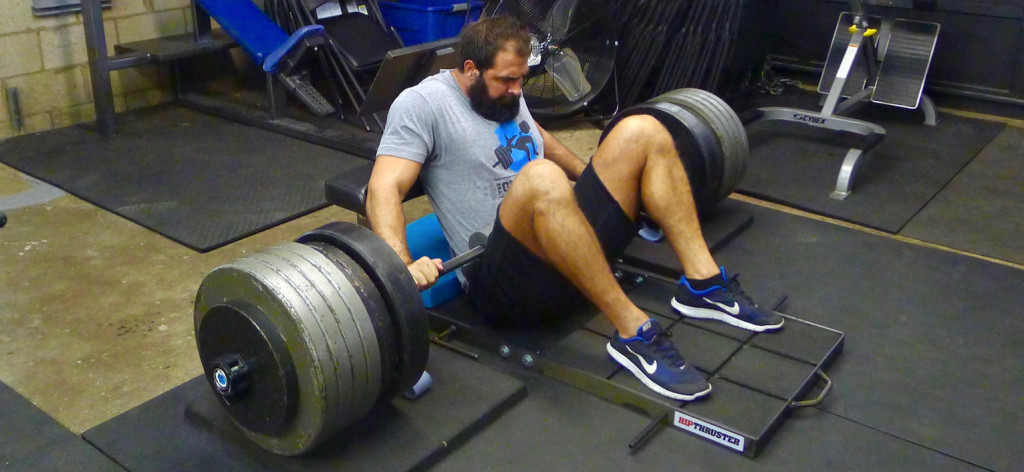
Barbell hip thrust
History
Old-Time Strongmen
Australian old-time strongman Don Athaldo appeared to have included the bodyweight isometric glute bridge as a means to strengthen the gluteals as early as the 1920’s. Interestingly, old-time strongmen performed a number of exercises that appear similar to barbell hip thrusting, including the neck bridge, belly toss, pullover and press, and Tomb of Hercules. The neck bridge involved bridging from the floor up onto one’s head in order to target the thoracic and neck extensors. It was done with bodyweight, with weight placed onto the hips, or with a barbell locked out over the shoulders. The belly toss involved catapulting a barbell situated at hip or belly level and catching it with the arms locked out, which could be thought of as a modern day explosive glute bridge combined with a floor press lockout. The pullover and press looked like a bridging movement but was actually an upper body movement performed in an isometric bridge position (alternating reps of pullovers and decline presses). The Tomb of Hercules required the strongman to hold himself in a bridge position while a vehicle or large animal traveled over a wooden bridge placed on top of the strongman’s torso.

Examples of strongman bridging exercises
Physical Therapy
Bodyweight supine bridging exercises have been popular for many decades, especially in the field of physical therapy. In fact, bridging holds are commonly used in the field to test core stability endurance (Schellenberg et al. 2007, Tidstrand & Horneij 2009, Brumitt et al. 2013). Physical therapist Tyson Alan wrote about the glute bridge as a rehabilitation exercise in Strength & Conditioning Journal in 2000 (Alan 2000). It was not until recently, however, that heavily-loaded bridging variations have become more mainstream in fitness and strength & conditioning communities. The bridging exercise has many names, usually consisting of 2 to 3 terms strung together. The first term is usually “glute,” “floor,” “supine,” “hip,” “pelvic,” or “lying”; the second term is usually “bridge,” “lift,” “thrust,” or “raise.” In Pilates, the movement is known as the shoulder bridge, while in yoga, the hold is known as Setu Bandha Sarvangasana pose.
Modern Strength & Conditioning
In the book Supertraining, sports scientists Yuri Verkoshansky and Mel Siff depicted a variety of partner-resisted double-leg and single-leg bridge variations that were proposed to be useful in developing and enhancing the cyclical action of the hips and legs during sprint running. They recommend that the resistance exercise, “should not only reproduce the full amplitude of the movement but also the specific direction of resistance to the pull of the muscles.”
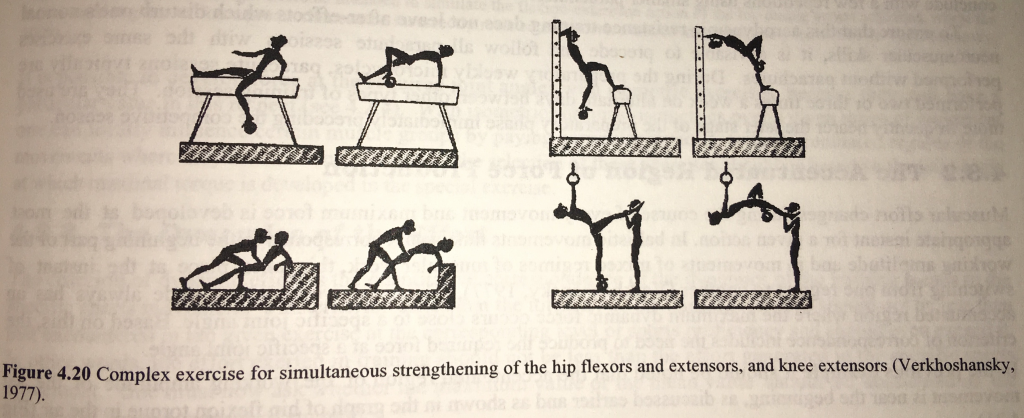
Yuri Verkoshansky should be credited as the originator of resisted hip thrusts for sport training – 1977
In 2006, strength coach Bret Contreras introduced heavy barbell glute bridges and hip thrusts to the strength & conditioning industry out of his Scottsdale-based personal training facility Lifts. In the years to come, he would come up with dozens of resisted single- and double-leg bridging variations utilizing dumbbells, barbells, resistance bands, chains, and combinations thereof. Contreras made the hip thrust a primary glute exercise in Strong Curves, a book he wrote with Kellie Davis in 2013. The numerous testimonials he has posted on his site showing impressive gluteal improvements provided compelling evidence to convince people to experiment with the hip thrust. He has been working hard on the research front to legitimize the hip thrust and has extensively studied the hip thrust in his PhD thesis titled Kinematics, kinetics, and electromyography of vertical and horizontal hip extension exercises and their transference to acceleration and power.
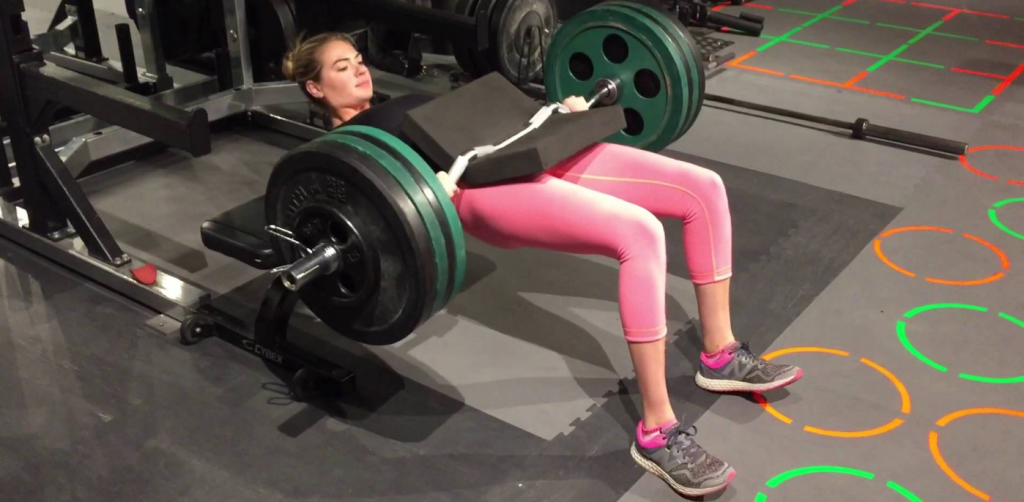
Kate Upton performing the hip thrust
Due to the cumbersome nature of the hip thrust setup that includes setting up and stabilizing a bench, in addition to the other equipment requirements inherent to the hip thrust exercise, apparatuses and devices that allow for a more comfortable and convenient setup, such as the Hip Thruster , Glute Builder, Booty Builder, and Nautilus Glute Drive are beginning to crop up around the world.
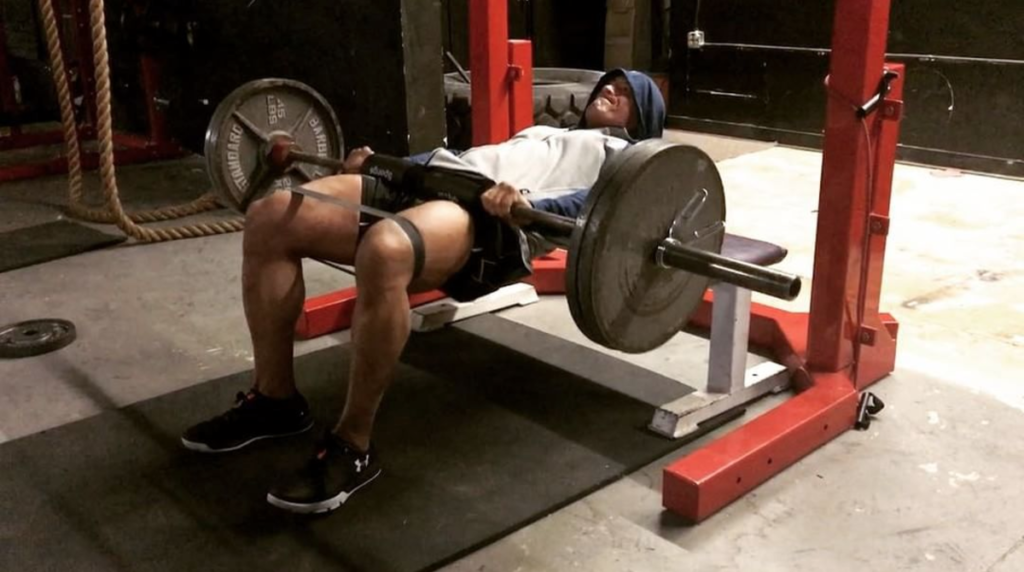
The Rock performing knee-banded barbell hip thrusts
Why People Hip Thrust
A poll undertaken in July of 2017 with 7,628 responders indicates that the majority (63%) of exercisers hip thrust for physique and aesthetics purposes (to get a better butt). The remaining people hip thrust for injury/pain prevention (16%), transfer to squats and deadlifts (12%), and functional performance outcomes (8%).
Muscles Worked
The barbell hip thrust heavily recruits the hip and knee extensors and is performed with the back against a bench. The American hip thrust is performed with the back elevated higher on the bench such that the hinging point is lower, and it leads to slightly higher hamstring and lesser quadriceps activation compared with the traditional hip thrust. The band hip thrust is performed with an anchored band placed around the hips and tends to exhibit lower average muscle activation levels, but similar peak muscle activation levels, compared to the barbell version. The barbell glute bridge is performed off the floor with the back on the ground and therefore involves a shorter range of motion. It elicits similar levels of gluteal and hamstring activation but lower levels of quadriceps activation. More research is needed to examine bodyweight and resisted single-leg hip thrusts, though pilot data indicates that loaded double-leg hip thrusts lead to greater overall levels of muscle activation.

Dani Shugart performing the hip thrust
Despite what the data suggests, muscle activation varies considerably between individuals, so the recommended approach is to experiment with different variations in order to determine the most effective forms of hip thrusting per individual.
- Gluteal group
- Gluteus maximus (upper subdivision)
- Gluteus maximus (lower subdivision)
- Hamstrings group
- Biceps femoris (long head)
- Semitendinosus
- Semimembranosus
- Adductor group
- Adductor magnus
- Adductor longus
- Adductor brevis
- Quadriceps group
- Vastus lateralis
- Vastus medialis
- Vastus intermedius
Technique
The hip thrust is a fairly simple exercise to perform. It is important to master bodyweight before adding resistance. This article details proper form with bodyweight hip thrusts. Here are the primary technique points to keep in mind when hip thrusting:
- Hinge on the bench from the lower scapulae region
- Push through the heels (feet can remain flat or the ankles can be dorsiflexed)
- Ensure vertical shins at the top of the movement
- Keep the knees out
- Achieve full hip extension
- Slightly posterior tilt the pelvis
- Keep the ribs down (move from the sternum down)
- Maintain forward eye gaze and keep the chin tucked
- Make fists and dig the arms into the bench (when performing the bodyweight hip thrust)
- Breathe big and brace core before each lift
- Pause at the top for a brief moment with a big glute squeeze
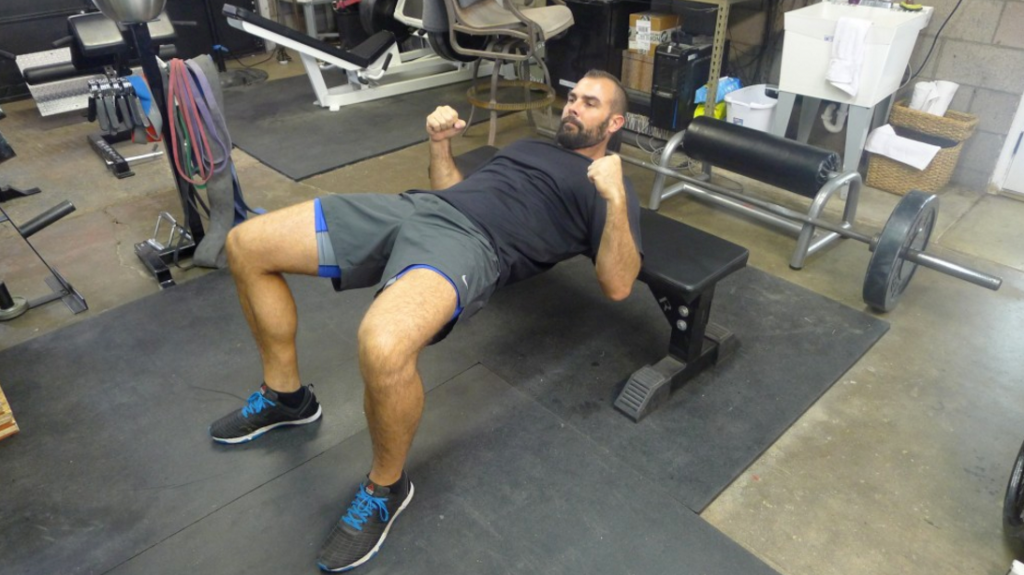
Proper bodyweight hip thrust technique
During the barbell hip thrust, the exerciser is encouraged to touch the buttocks or the plates on the barbell down to the ground when performing hip thrusts from recommended bench height (see below). However, in situations where taller benches must be used (most commercial gyms possess benches that are taller than suggested heights), it is recommended that the exerciser avoid touching down to the ground and instead reverse the motion in mid-air.
This video details proper hip thrust form:
Equipment
In order to perform the hip thrust exercise, an elevated and stable platform is required upon which to rest the back. The recommended bench height is 12 to 16 inches (30 to 40 centimeters). Benches secured against a wall or power rack are the most common implements, but the following can also be utilized: aerobic steps with 4 to 6 risers per side, plyometric boxes with padding, custom-built platforms, Hip Thrusters (Hip Thrusters are 16″ high with a 2″ foot mat, so the difference yields a 14″ or 35.5 cm bench height) and even heavy punching bags. If using a bench that is too tall, an Airex balance pad can be placed underneath the buttocks of shorter subjects or subjects with relatively short torsos in order to allow for more normal range of motion, or the individuals can place their feet on steps.
Once proficiency is reached with bodyweight, resistance can be added. The most common ways to achieve this are with dumbbells, barbells, and resistance bands. When using a barbell, it is important to utilize thick bar padding in order to protect the hips. The most popular brands of thick bar padding include the Squat Sponge, Airex balance pad, and the Hampton extra thick bar pad. Thick bar padding can make rolling the barbell over the thighs challenging, however, so 1.5” thick mats, DC Blocks, or 45 lb. plates can be placed underneath the barbell plates in order to provide more space for the hips in between the bar and the ground.
When using resistance bands around the hips, the most popular methods of securing the bands involve hooking the ends around a power rack or Smith machine. However, innovative strategies involving combinations of dumbbells and plates have also been used successfully. Apparatuses such as the Hip Thruster allow for convenient band hip thrust performance. Resistance can also be placed around the knees in the form of minibands (loops) or a medium Hip Circle or Glute Loop.
A weightlifting belt is not needed for this exercise. Recommended footwear includes barefoot, minimalist shoes, flat-soled shoes (such as Chuck Taylors), or tennis shoes, but not Olympic weightlifting shoes.
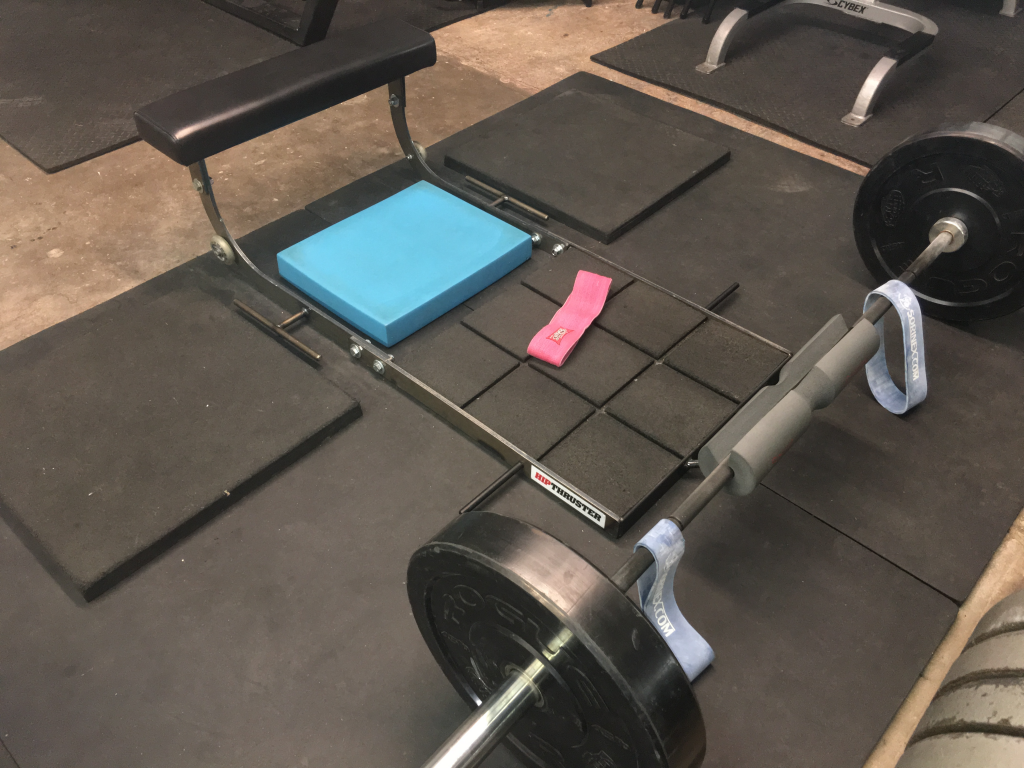
Variations
The most popular hip thrust variations are the barbell, band, and single-leg. However, there are numerous potential variations depending on limb number, elevation, back position, foot position, resistance, tempo, and device. This article depicts numerous hip thrust variations, though simple mathematical calculations suggest that there are at least 7,000 possible hip thrust variations using the criteria below. Many individuals figure out through experimentation that they have a strong preference for some variations over others due to the individuality inherent to human motor control. Listed below are all the possible ways to vary the hip thrust.
- Limb number
- Two (double leg)
- One (single leg)
- Standard (top leg free)
- Braced (top leg braced on box)
- B-stance (aka staggered or kickstand)
- Elevation
- Floor
- Shoulders-elevated
- Feet-elevated
- Shoulders- and feet-elevated
- Back position
- Standard
- American
- Ankle position
- Flat
- Dorsiflexed
- Neck/spinal/pelvic strategy
- Neutral neck & spine with hip hyperextension (hinge method)
- Chin tucked with slightly lumbar extension and anterior pelvic tilt at bottom ROM transitioning to slight lumbar flexion + posterior pelvic tilt at top of ROM/lockout (move from sternum down method)
- Foot position
- Standard (medium, straight)
- Narrow
- feet straight
- feet turned in slightly
- Wide
- feet straight
- feet turned out
- Frog
- Knee position
- Standard (knees aligned with feet)
- Knees slightly in (used with wider stances)
- Knees slightly out (used with narrower stances)
- In/out (used with knee bands – valgus at bottom, neutral at top)
- Bar on hips strategy
- Bar stays above pubic bone
- Bar rolls to upper thighs
- Resistance
- Bodyweight
- Ankle weight (for single-leg)
- Knee-banded
- Hip-banded
- Chain
- Dumbbell
- Symmetrical (used with bilateral)
- Asymmetrical (used with unilateral)
- Barbell
- Landmine (for single-leg)
- Combinations
- Hip plus knee-banded
- Dumbbell plus knee-banded
- Bar plus knee-banded
- Bar plus hip-banded
- Bar plus hip- plus knee-banded
- Bar plus chains
- Bar plus chains plus knee-banded
- Bar plus dual bands
- Bar plus dual bands plus knee-banded
- Belt/Roller (Booty Builder, Glute Drive, Matrix)
- Tempo
- Standard
- Pause
- 1-sec
- 3-sec
- 5-sec
- Isohold
- Constant tension
- Rest pause/cluster
- Eccentric-accentuated
- Enhanced eccentric
- 1 1/4 pulses
- Triple pulse
- Dynamic effort (speed)
- ROM
- Standard (full) – plates touch down
- Reverse in mid-air (still full ROM but used with higher benches)
- Top ROM partials
- 21’s (7 top, 7 bottom, 7 full ROM)
- Device
- Bench
- Decline bench
- Rack
- Smith machine
- Lying leg curl/leg extension
- Hip Thruster/Booty Builder/Glute Builder/Glute Drive/Skorcher/Glute Trainer
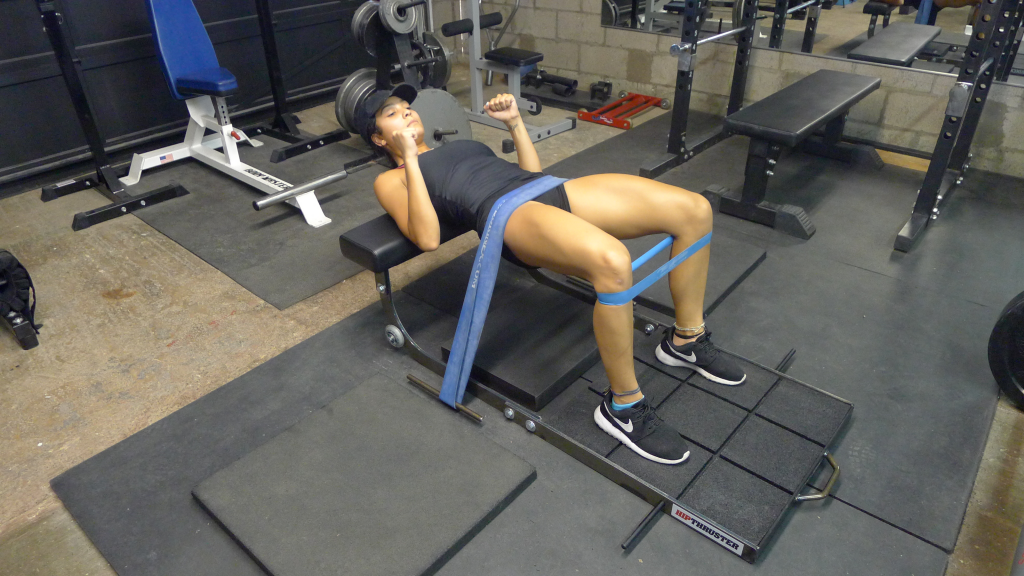
Double band hip thrust
Safety
There are several important safety considerations associated with the hip thrust.
- Utilize a stable bench. The bench cannot slide around or tilt back and should be secured to or against a fixed implement.
- Ensure the bench or platform has ample padding. This will protect the upper back from getting scraped.
- Use thick bar padding. When using a barbell, this can protect the hips from discomfort and bruising.
- Ensure optimal spinal and pelvic positioning. The most common complaint associated with the hip thrust exercise is lower back discomfort. This is almost always due to an extended lumbar spine and anteriorly rotated pelvis. By keeping the chin tucked and the ribs down, spinal hyperextension is avoided, erector muscle activation is reduced, spinal compressive and shearing forces are reduced, and facet joint contact forces are minimized. This technique makes the hip thrust more of a pure hip exercise instead of a hip and back exercise.
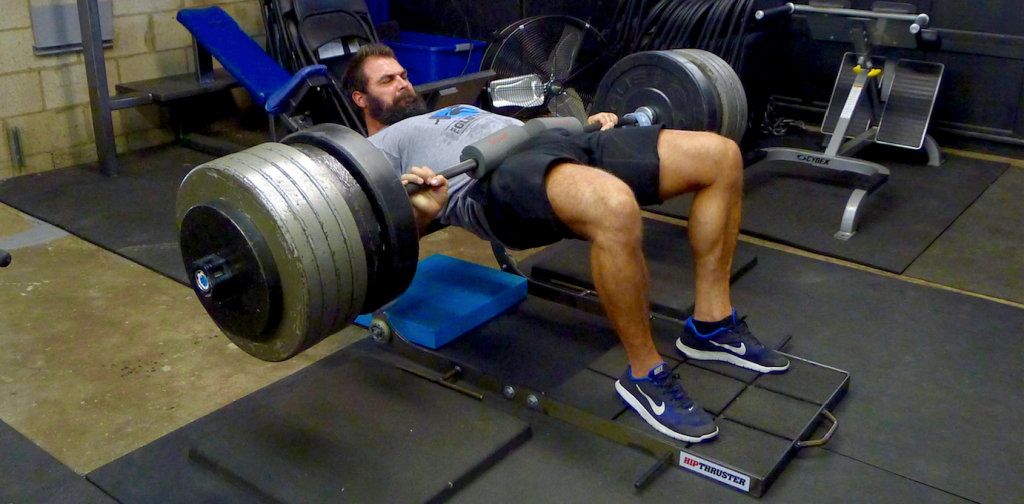
Chin tucked and pelvis tilted posteriorly at lockout
Perception of Safety
The hip thrust is perceived as a very safe exercise. A poll undertaken in July of 2017 with almost 5,200 responders indicated that:
- Most lifters rate squats and deadlifts at a 5 in terms of level of danger and a hip thrust at 1 (1 being least dangerous and 10 being most dangerous)
- 61% of lifters have hurt themselves 1 or more times in the past decade with squats, 64% with deadlifts, and only 17% with hip thrusts
- Between squats, deadlifts, and hip thrusts, 96% of lifters believe squats to be the most risky lift for the knees, and 71% of lifters believe deadlifts to be the most risky for the low back


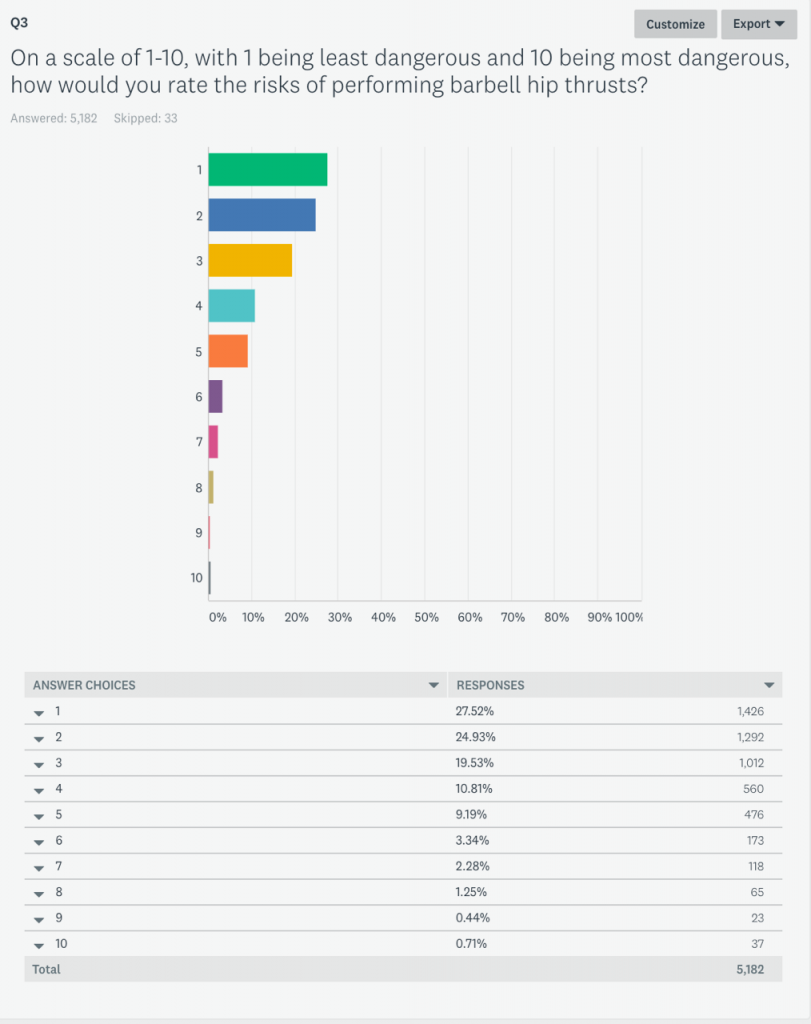

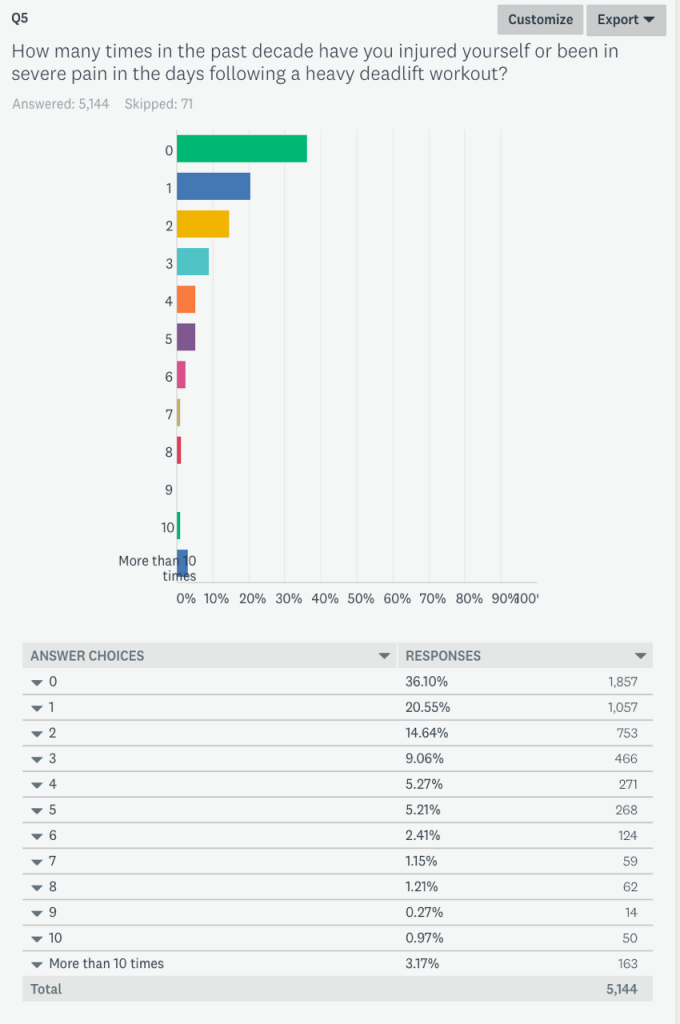

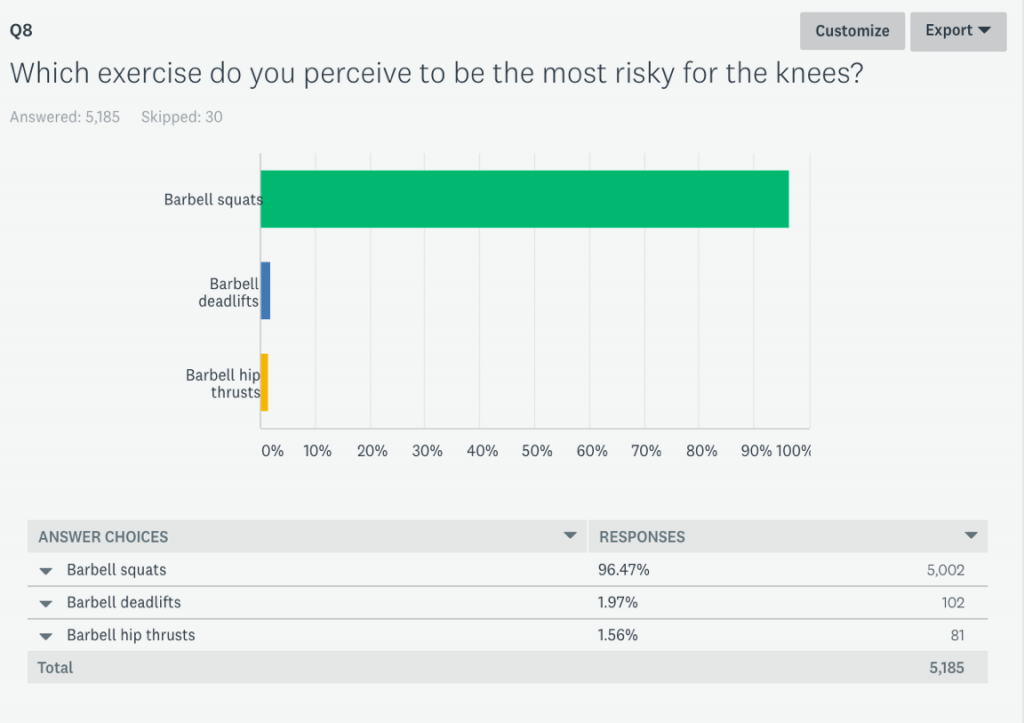
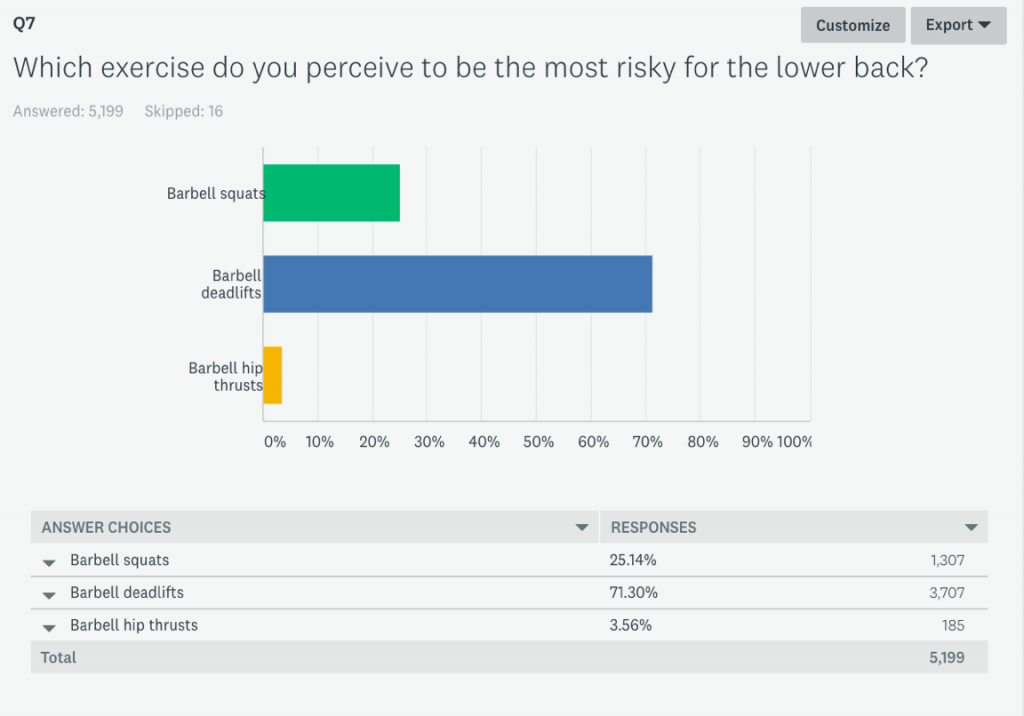
Preferred Glute Exercise
In a survey of my followers involving 13,699 participants, the hip thrust was voted as the favorite glute exercise.
To see the answers to all 25 questions in the survey (each pertaining to glute training), click HERE.
Biomechanics
Mechanics
One primary feature of the barbell hip thrust is the heavy loading that can be utilized by nearly all individuals who regularly perform the exercise. Due to the three points of contact at the mid-back along the bench and the two feet upon the floor, the exercise is highly stable and easy to learn. It does not contain a sticking region as seen in the squat and bench press. The most difficult portion of the hip thrust seems to be at the exercise’s lockout, not at the bottom or in the middle of the range of motion. The hip thrust is characterized by a consistent level of tension on the hips throughout its range of motion, unlike the squat or deadlift, which place greater levels of tension at the bottom of the range of motion in the stretch position compared to the top in the lockout position. The hip thrust therefore has a flattened hip extension torque angle curve, whereas the squat and deadlift possess a descending hip extension torque angle curve.

Estimated hip extension torque angle curves associated with various popular glute exercises
Individuals of all body types can learn to perform the hip thrust in a coordinated fashion. Whereas relatively long femurs are disadvantageous in the back squat exercise as they lead to greater extensor torque requirements out of the hips and knees, in addition to a greater degree of torso lean, they don’t pose a disadvantage in the hip thrust. Shorter individuals and those with relatively short torsos will require a shorter bench height during the hip thrust. Individuals with long tibias and greater hip extension range of motion will utilize slightly greater range of motion in terms of overall barbell displacement during the thrust.
The Effect of Stance
This is recent, unpublished-as-of-yet data that I collected with Erin Feser at ASU. It examines glute bridges, but this almost certainly applies to hip thrusts as well. We found that knee-banded glute bridges (mini-band placed right above the knees with a 2X hip-width stance), max contraction (flexing your glutes as hard as possible throughout the rep), and frog pumps (heels touching each other with knees flared outwards) were best for the upper glutes, while max contraction, frog pumps, and knee-banded glute bridges were best for lower glutes. Narrow stance bridges ranked lowest in glute activity.
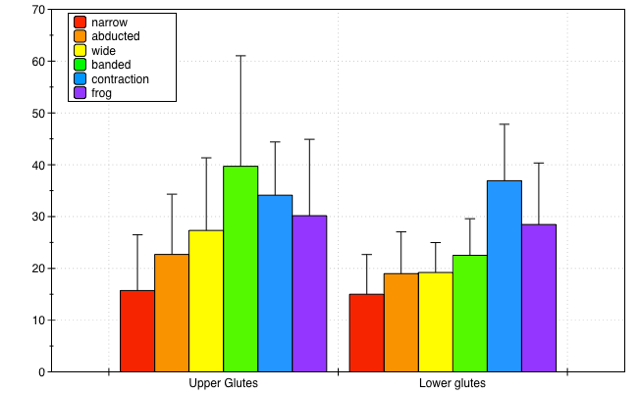
The Effect of Load
Heavier hip thrusts do in fact increase glute activity, but the slope of this increase is not very impressive. At 50% of 1RM, the first rep of a hip thrust set activates the glutes to around 40% of MVIC, whereas at 90% of 1RM, the first rep of a hip thrust set activates the glutes between 50-60% of MVIC. Considering that around 20 reps can be performed with 50% of 1RM and only 3 reps can be performed with 90% of 1RM, this may indicate that lighter loads for higher reps are superior for glute hypertrophy in comparison to heavier loads for low reps.
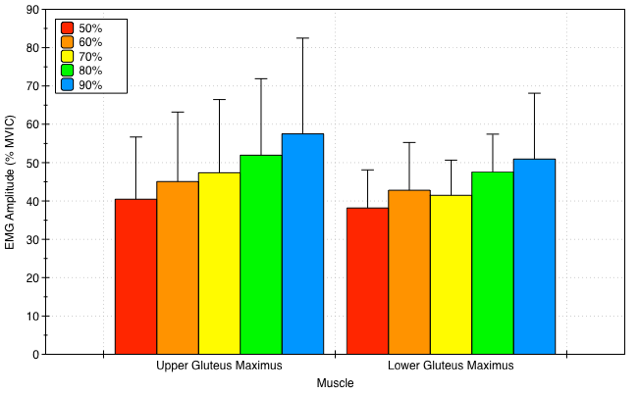
Lever Type
Whereas the squat is a type III lever, the hip thrust is actually two type III levers. Biomechanist Andrew Vigotsky depicts this concept below:
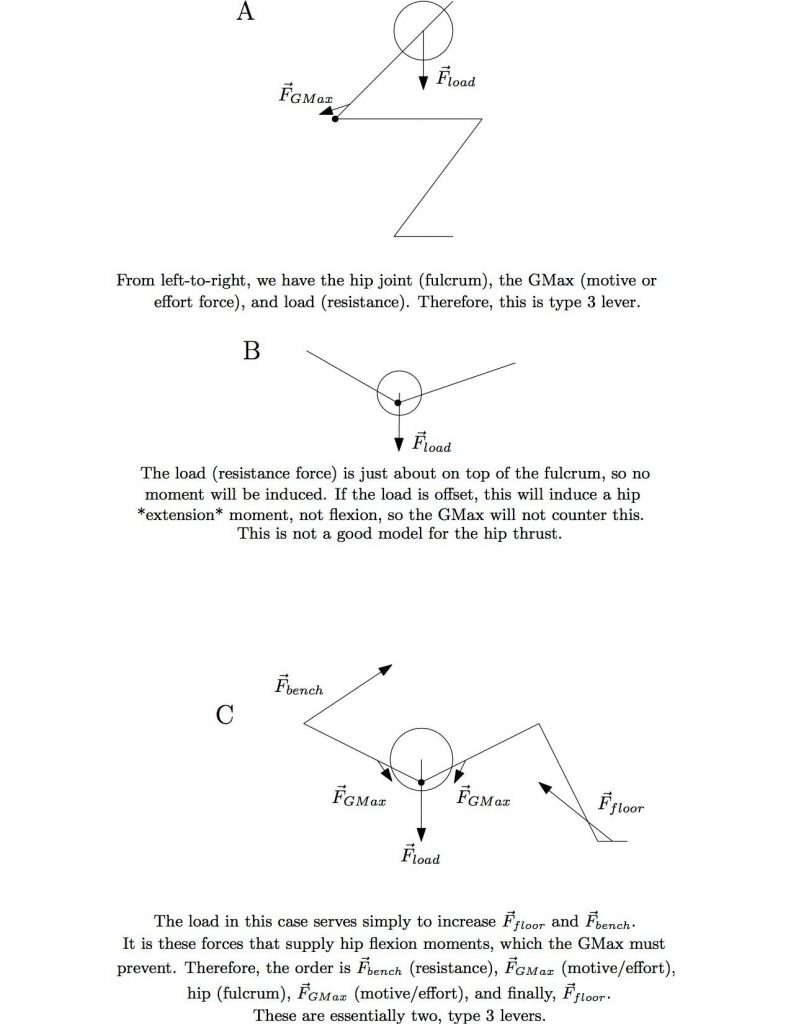
Lumbopelvic Hip Complex (LPHC) Kinematics
The range of hip extension mobility varies remarkably in humans, with some individuals possessing 5 degrees of hip hyperextension mobility, and others, 40 degrees of hip hyperextension mobility (Elson & Aspinall 2008). In the hip capsule, hip hyperextension and posterior pelvic tilt mimic each other, with hip hyperextension rotating the hip onto a fixed pelvis and posterior pelvic tilt rotating the pelvis onto a fixed femur (Neumann 2010). During the hip thrust, a variety of lumbopelvic hip complex positions can be utilized depending on the individual and his or her goal(s). For example, at the top of the hip thrust, if the lumbar spine is extended, the pelvis is anteriorly tilted, and the hips are hyperextended, barbell displacement (range of motion) will be maximized. However, in order to protect the spine, it is recommended that the lumbar spine be in the neutral range or slightly flexed and the pelvis posteriorly tilted at the top of the hip thrust. Holding a flexed neck position (maintaining forward head position throughout the duration of the set of hip thrusts) will assist with minimizing erector activation and lumbar lordosis (Shirado et al. 1995). This strategy will reduce barbell displacement, and though it may give the appearance of suboptimal range of motion, it will still max out hip extension mobility in the hip capsule, thereby allowing for near maximum levels of gluteal activation.
Hip Extension Torque
A complicated biomechanical technique known as the inverse dynamics is required to accurately calculate the hip extension moment arms and moments, which determine the torque or turning force requirements from the hip extensor musculature. However, these measurements can be estimated to a reasonable degree by utilizing the floor reaction force vector (FRFV) method as shown below by biomechanist Andrew Vigotsky:
While the graph provided above in the mechanics section provides simplified estimates of joint torques, specialized software that takes into account 3D motion capture and force plate data must be utilized in concordance with inverse dynamics in order to more accurately predict the joint torques during movement. Ian Bezodis and his team recently used a Vicon system to do just this, and below are their findings when examining 70% 1RM hip thrust loads.
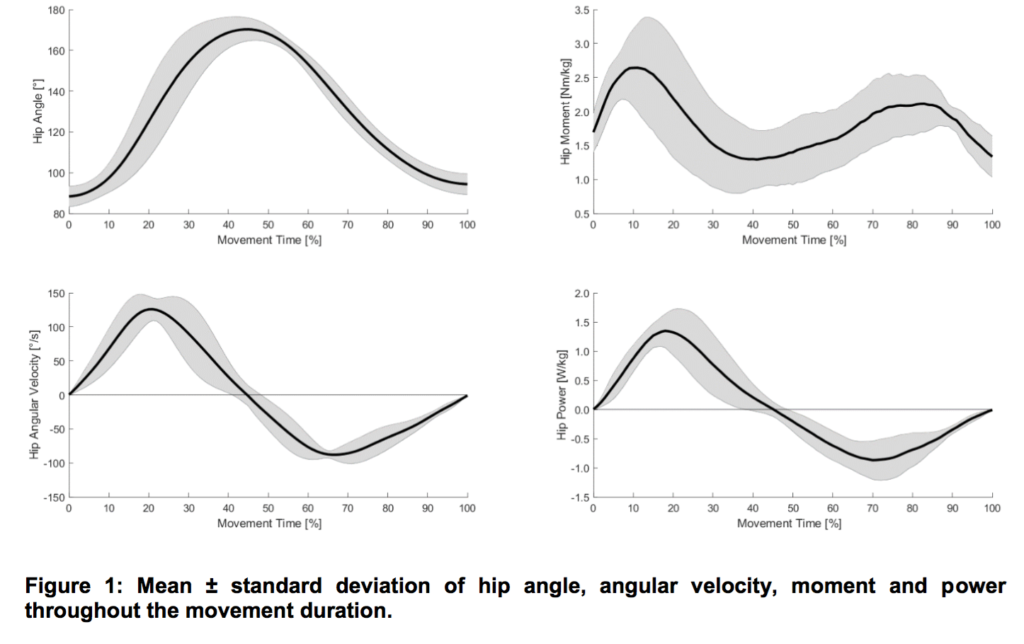
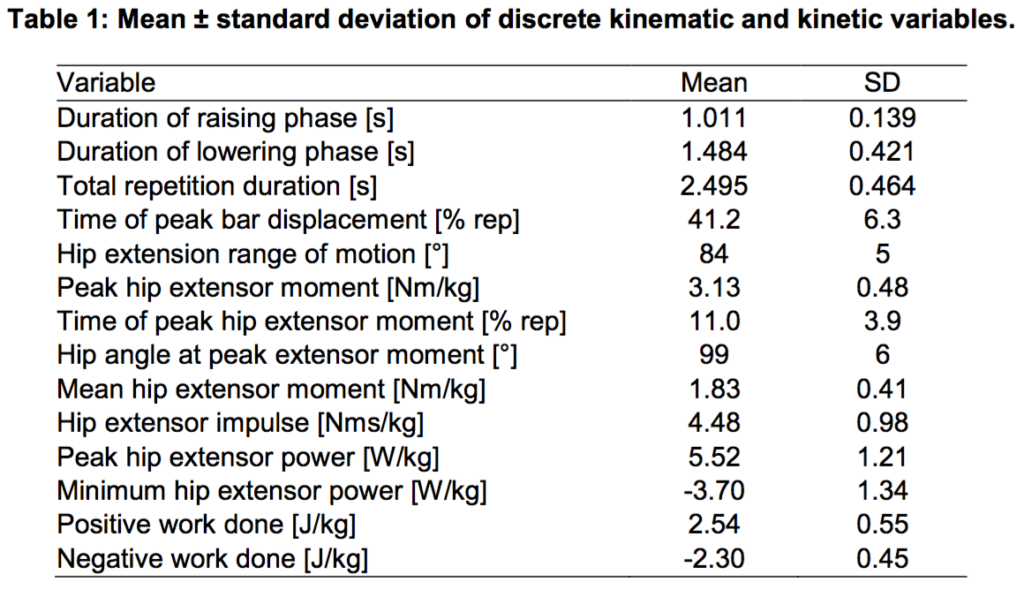
Interestingly, they found that peak joint moments (torques) occurred near the bottom of the hip thrust, not the top. Though athletes “feel” hip thrusts most at the top of the movement, the greatest loading occurs at the bottom. This can easily be explained by examining the strength curve of the hip extensors. Since the hips are markedly stronger (around 2.5X stronger) at extending the hips when they’re in deep hip flexion compared to full hip extension, it is indeed “harder” for the hips near the top since their strength is tapped to a greater proportion.
Another experiment by Bezodis’s group compared the hip extension torque angle curves between squats, deadlifts, and hip thrusts which are shown below.
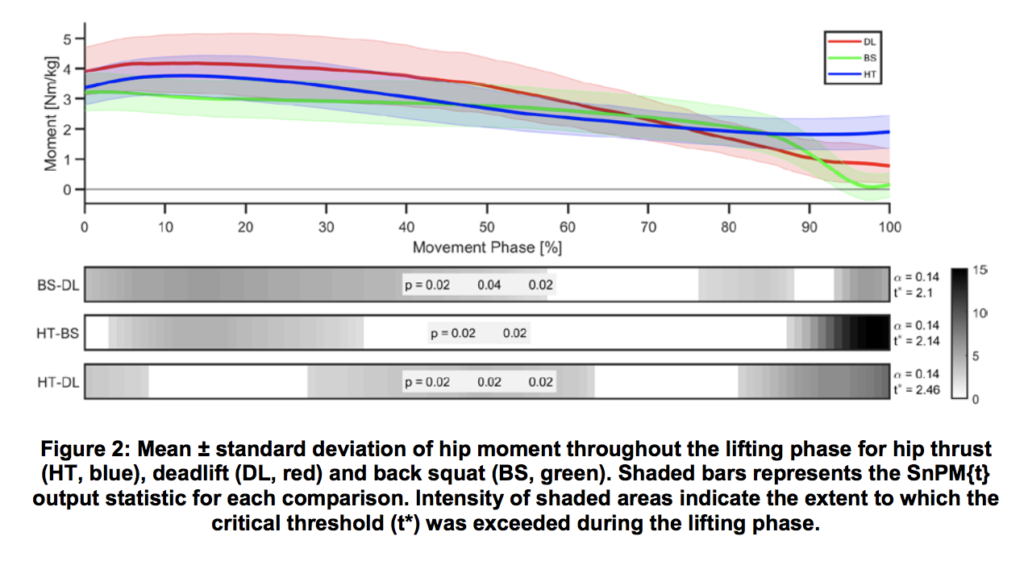
As you can see, the hip thrust exhibits greater end-range hip extension torque than squats and deadlifts.
Electromyography (EMG) Amplitude & Gluteal Hypertrophy
Peak activation positions likely have implications for exercise selection and hypertrophy. Since the hip thrust exhibits very high levels of hip extension torque at end-range hip extension, where the gluteus maximus exhibits maximum levels of EMG amplitude, this leads to high levels of tension and motor unit recruitment in the gluteus maximus.
Peak Gluteus Maximus EMG Position
The gluteus maximus exhibits peak levels of EMG amplitude in a shortened position at end-range hip extension (lockout). This was demonstrated in the literature as early as 1968 by Fischer and Houtz, and again in 2001 by Worrell et al. In addition, the maximum voluntary isometric contraction (MVIC) position for the gluteus maximus is the prone bent-leg hip extension in knee flexion against manual resistance applied to the distal thigh (Contreras et al. 2015), further demonstrating that peak glute activation is elicited in full hip extension.
Impact of Simultaneous Knee & Hip Extension on Gluteus Maximus EMG
When the knees and hips extend simultaneously, gluteus maximus activity is diminished. This was first demonstrated by Yamashita in 1998. This mechanism provides further rationale for the hip thrust being a better choice for gluteal hypertrophy than squats, lunges, or leg presses. The same phenomenon occurs with the rectus femoris (Ema et al. 2016) and explains why leg extensions are a better choice for rectus femoris hypertrophy than squats, lunges, or leg presses.
Impact of Hamstring Active Insufficiency on Gluteus Maximus EMG
The knees stay bent and the hamstrings stay shortened during the hip thrust exercise. This reduces their contribution to hip extension torque and increases the involvement of the gluteus maximus (Kwon & Lee 2013, Lim & Kim 2013, Park & Yoo 2014, Jeon et al. 2016, Norikazu & Masaaki 2018, Hirose & Tsuruike 2019). The same phenomenon occurs with the vastis when the rectus femoris is shortened (Maffiuletti & Lepers 2003), and this is referred to as “active insufficiency,” which forces the prime movers to increase their recruitment in order to compensate for the weakened and shortened biarticular synergist.
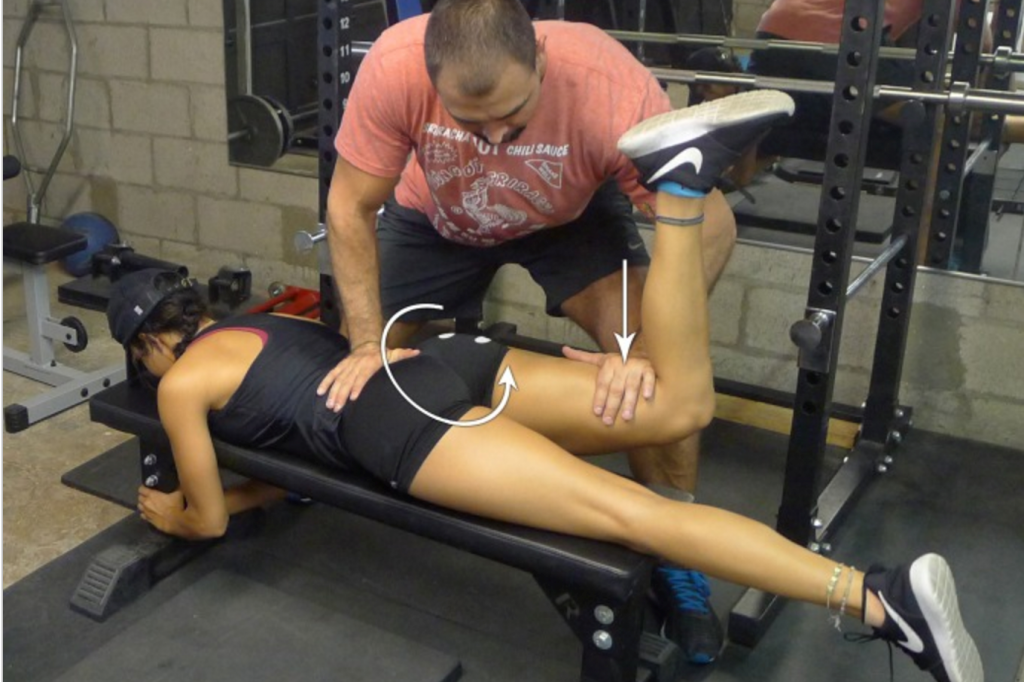
Gluteus maximus MVIC position: Similar to top hip thrust position
Hamstring Mechanics in the Hip Thrust
Hamstring activation in the hip thrust is much greater than that observed in a back squat, but lower than that observed in a deadlift. While hip extension torque requirements are more consistent in the hip thrust compared to the squat, the hamstrings are more lengthened and in a better position to produce force in the deadlift compared to in the hip thrust. It is this shortened position, combined with great hip extensor demands, that may cause individuals performing the hip thrust to experience a cramping sensation in their hamstrings.
Quadriceps Mechanics in the Hip Thrust
Knee extension torque is high in the hip thrust exercise for three reasons. First, subjects push back into the bench for stability during the hip thrust; second, knee extension will raise the hips in a hip thrust, thereby creating hip extension movement; and third, since slight knee extension takes place, the quads must counteract the high levels of hamstring involvement at the knee. In other words, while the hamstrings extend the hips, they also produce knee flexion torque, which must be countered by the quadriceps if knee extension is to take place (Bryanton et al. 2015).
In contrast to the gluteus maximus, which exhibits peak EMG amplitude in maximally-shortened positions, the vastis muscles of the quadriceps exhibit peak EMG amplitude in mid-range and stretched positions (Kong & Van Haselen 2010, Shenoy et al. 2011, Pincivero et al. 2004).
Since the squat and hip thrust exercises both require very high net knee extension torque at mid-range knee extension, where the vastis exhibit maximum levels of EMG amplitude, this leads to high levels of tension and motor unit recruitment in the quadriceps. However, because the knees move through a much greater range of motion during the squat compared to during the hip thrust, the dynamic nature of the squat makes it superior to the hip thrust for quadriceps hypertrophy.
Adductor Mechanics in the Hip Thrust
Adductor involvement is also high in the hip thrust exercise due to the fact that the adductors are exceptional hip extensors, particularly in deep hip flexion (Vigotsky & Bryanton 2016). The adductor magnus in particular is a powerful hip extensor, and it contributes significantly to the hip extension torque production during the hip thrust.
Erector Spinae Mechanics in the Hip Thrust
Head, neck, spine, and pelvic position modify spinal erector activity during the hip thrust. If seeking to maximize spinal erector activation, an extended head, neck, and spine, and an anteriorly tilted pelvis are advised. However, this posture places increased stress on the posterior elements of the spine (Cavanaugh et al. 1996). It is therefore recommended that the chin stay tucked, head position remain forward, the chest/ribs down, and the pelvis posteriorly tilted in order to reduce spinal erector activity and make the hip thrust more of a pure hip extensor exercise.
Ab/Core Influence on Gluteus Maximus Activity
Using the abdominals in addition to the gluteals during hip extension increases glute activity (Chan et al. 2017, Sharon et al. 2018). Inversely, squeezing the gluteals during a plank into a posterior pelvic tilt vastly increases abdominal and oblique activation (Schoenfeld et al. 2014). The glutes and abdominals are linked via a “force couple,” and the abs could be thought of as a hip hyperextensor via their role in producing posterior pelvic tilt. Though it has not yet been examined, actively posterior pelvic tilting at the top of the hip thrust using the glutes and the abdominals may enhance gluteal activity.
The Mind Muscle Connection During the Hip Thrust
Utilizing an internal versus an external attentional focus during hip extension increases gluteal EMG activity (Lewis & Sahrmann 2009, Holman et al. 2018). Pilot data from 2014 by Contreras clearly displayed this phenomenon as well (see table below).
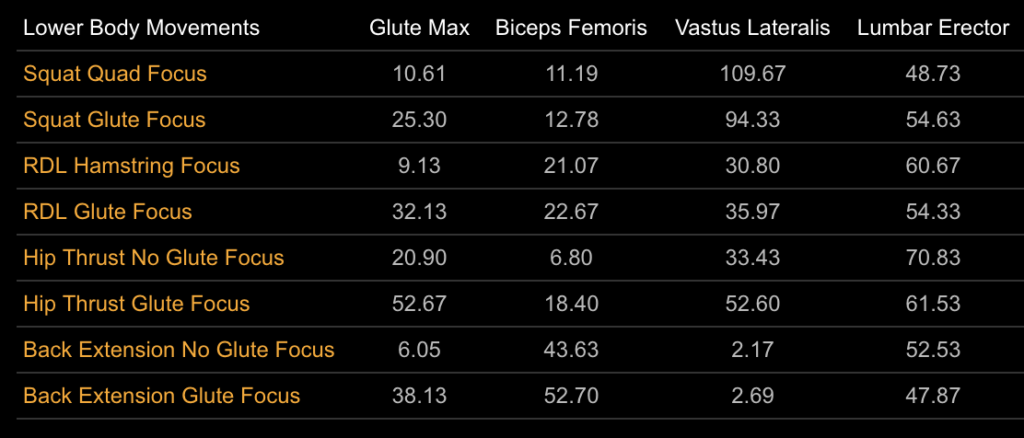
Hip Thrust versus Back Squat and Front Squat
Below is a chart showcasing the findings of Bret Contreras’s thesis, which compared the squat and the hip thrust using EMG, force plate, video capture, ultrasound, and performance tests.

From Kinematics, kinetics, and electromyography of vertical and horizontal hip extension exercises and their transference to acceleration and power
In comparison to the back squat, the hip thrust utilizes a lesser hip range of motion and less force during the eccentric (lowering) phase of the movement. This likely leads to less muscle damage in the gluteals. However, the consistent torque on the hips, greater concentric force production, and greater concentric velocity in the hip thrust likely lead to greater mechanical tension/stress, motor unit recruitment/activation, and metabolic stress/fatigue in the gluteals in comparison to the back squat. Moreover, the hip thrust recruits the upper fibers of the gluteus maximus to a much greater degree than does the back squat (in general, horizontal or anteroposterior hip extension exercises recruit more upper gluteus maximus fibers than vertical or axial hip extension exercises).
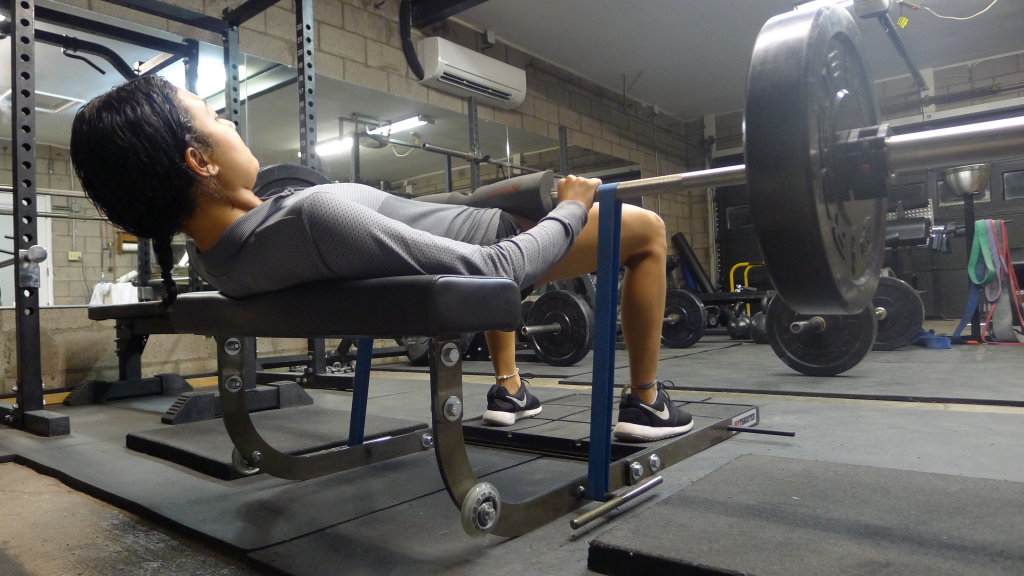
Barbell plus band hip thrust
Taking all biomechanical factors into consideration, the hip thrust appears to be a better exercise than the back squat for enhancing gluteal and hamstring hypertrophy, which is in line with the recommendations of Ebben & Jensen, 2000. These muscular adaptations have not yet been demonstrated in the literature by randomized controlled trials, however. Future research is needed to elucidate the hypertrophic effects of the hip thrust exercise.
Although research is limited, one published study and three in various stages of publication indicate that hip thrusts are better suited than squats for improving sprint acceleration, horizontal jump, isometric mid-thigh pull force, isometric horizontal pushing force, hip thrust strength, and gluteal hypertrophy. Squats appear to be better than hip thrusts for improving vertical jump, agility, and squat strength. Moreover, hip thrusts appear to be a valuable assistance exercise for improving the squat and deadlift, leading to approximately half of the strength gains as performance of the specific lifts themselves. Hip thrusts appear to build the squat better than the deadlift and the deadlift better than the squat.
Some of these effects are likely due to the different force vectors associated with the two exercises. The force vector is the direction in which force is applied with respect to the body. Often, force vectors are referred to as “vertical” and “horizontal”; although, the correct terms are axial (for vertical) and anteroposterior (for horizontal), as these refer to force directed from the feet towards the head, and force directed from the back of the body to the front of the body, respectively.
The squat has an axial force vector, wherein force is transferred by the feet into the ground, and the direction of the force is from the feet towards the head. If the force vector is important, we might expect the squat to transfer better to athletic abilities involving axial movements, like vertical jumping. On the other hand, we might expect it to transfer less well to athletic abilities using anteroposterior movements, like broad jumps and sprinting. Equally, the hip thrust exercise has an anteroposterior force vector, wherein force is applied through the feet into the ground and through the back into the bench, and the direction of the force is from the back of the body towards the front of the body. If the force vector is important, we should expect the hip thrust to transfer better to athletic abilities involving anteroposterior movements, like broad jumping and possibly even sprinting. On the other hand, we might expect it to transfer less well to athletic abilities involving axial directions, like vertical jumps.
Numerous studies have been performed in relation to the role of horizontal (anteroposterior) force production in sprinting. Although sprinters need to perform work against the force of gravity (i.e., vertically), they also need to perform work to accelerate in a horizontal direction against air resistance and ground friction, in addition to overcoming inertial forces of the body. In fact, biomechanically, an increase in sprinting speed can only be attained if horizontal propulsive impulse (force x time) exceeds horizontal braking impulse in the ground contact phase. Only this scenario will allow an athlete to accelerate to a faster speed than they are currently running. The research is quite clear in showing that horizontal force production is more important than vertical force production during sprint acceleration and faster running speeds (Hunter et al. 2005, Morin et al. 2011, Morin et al. 2012, Kawamori et al. 2013, Morin et al. 2015, Brughelli et al. 2011, Buchheit et al. 2014, Cross et al. 2015, de Lacy et al. 2015, Rabita et al. 2015).
The hip thrust strengthens the glutes at hip ranges of motion that are more associated with ground contact compared to squats. Research indicates that the gluteus maximus is the most important hip extensor on the ground, whereas the hamstrings are the most important in the air (Schache et al. 2010, Kryolainen et al. 2005, Dorn et al. 2012). Additionally, the hamstrings have been found to be critical in producing horizontal force production (Morin et al. 2015).

Hip Thrust Correlations
Several published papers and master’s theses have determined correlations between hip thrust strength and measures of lower body strength and power. Here is data from Vallance, 2017.
Comparison to Glute Bridge
Korta, 2018 compared the hip thrust to the glute bridge and the results are shown below.
Published Research
There are currently 40 peer-reviewed published journal articles, preprints, and master’s theses that pertain to the hip thrust exercise:
-
- Barbell Hip Thrust: Exercise Technique – This article was published by Bret Contreras, John Cronin, and Brad Schoenfeld in Strength & Conditioning Journal. It described proper hip thrust technique and protocols.
- Barbell Hip Thrust – This is another technique article published in Journal of Sport and Human Performance and written by Ryan Eckert and Ronald Snarr describing proper hip thrust technique.
- The effect of maturation on adaptations to strength training and detraining in 11-15-year-olds – This study was carried out by Cesar Meylan and colleagues and published in Scandinavian Journal of Medicine & Science in Sports. It looked at the effects of strength training on strength, acceleration, and power in adolescent males in different stages of maturation. Hip thrust variations were included as part of the training regimen, and marked increases in performance were observed.
- Effects of hamstring-emphasized neuromuscular training on strength and sprinting mechanics in football players – This study was carried about Jurdan Mendiguchia and colleagues and published in Scandinavian Journal of Medicine & Science in Sports. It examined the effects of hip thrust variations, eccentric knee flexion exercises, and sled towing on speed, ground reaction force, and knee extensor/flexor muscle strength in soccer players. The experimental group saw greater increases in speed and leg strength compared to the control group.
- A Comparison of Gluteus Maximus, Biceps Femoris, and Vastus Lateralis Electromyographic Activity in the Back Squat and Barbell Hip Thrust Exercises – This study was carried out by Bret Contreras and colleagues and published in Journal of Applied Biomechanics. EMG amplitude was measured in resistance trained women during the back squat and hip thrust. The hip thrust elicited greater mean and peak EMG amplitudes in the upper and lower gluteus maximus as well as in the hamstrings, but quadriceps activity was similar between the two exercises. In addition, hip thrust isometric holds exhibited far superior hip extensor EMG amplitude compared to squat isometric holds.
- A Comparison of Gluteus Maximus, Biceps Femoris, and Vastus Lateralis Electromyography Amplitude for the Barbell, Band, and American Hip Thrust Variations – This study was carried out by Bret Contreras and colleagues and published in Journal of Applied Biomechanics. EMG amplitude was measured during the barbell, band, and American hip thrust variations. In general, the barbell hip thrust was found to be the superior variation for gluteal EMG amplitude. However, some subjects achieved their highest levels of gluteal EMG amplitude during the band and American hip thrusts, indicating that individual experimentation is warranted.
- Effects of a six-week hip thrust versus front squat resistance training program on performance in adolescent males: A randomized-controlled trial – This study was carried out by Bret Contreras and colleagues and published in Journal of Strength and Conditioning Research. One group of adolescent rugby players performed solely front squats for lower body training, whereas another group performed solely hip thrusts. The front squat group saw greater increases in front squat strength and vertical jump performance. The hip thrust group saw greater increases in hip thrust strength, acceleration performance, and isometric mid-thigh pull strength. Furthermore, the study showed that squats transferred to hip thrusts and hip thrusts to squats at around half the rate of the specific lift. This provides preliminary evidence supporting the force vector theory and indicates that both squats and hip thrusts should be included in a comprehensive strength and conditioning program.
- Effects of 6-week squat, deadlift, or hip thrust training program on speed, power, agility, and strength in experienced lifters: A pilot study – This article by Michael Zweifel and colleagues published in the Journal of Trainology (click HERE for his master’s thesis) collected important pilot data that will be used in future research to test how squats, deadlifts, and hip thrusts uniquely impact performance and strength. The researcher believes that all 3 exercises are required to maximize acceleration, explosive power, and agility.
- Electromyographic Comparison Of Barbell Deadlift, Hex Bar Deadlift And Hip Thrust Exercises: A Cross-Over Study – This study by Vidar Anderson and colleagues published in Journal of Strength and Conditioning Research examined gluteus maximus, biceps femoris, and erector spinae EMG activity between the conventional deadlift, trap bar deadlift, and barbell hip thrust. Deadlifts elicited the highest hamstring activity, hip thrusts elicited the highest glute activity, and erector activity was similar between all three exercises. Moreover, hip thrusts exhibited higher hip extensor activity in the latter half of the concentric phase.
- A Multifactorial, Criteria-based Progressive Algorithm for Hamstring Injury Treatment – This paper by Jurdan Mendiguchia and colleagues published in Medicine & Science in Sports & Exercise utilized bilateral and unilateral hip thrust variations in an individualized algorithm designed to rehabilitate hamstring strain injuries. The experimental group experienced markedly less re-injuries than the control group that performed Nordics.
- The Potential for a Targeted Strength Training Programme to Decrease Asymmetry and Increase Performance: A Proof-of-Concept in Sprinting – This case study by Scott Brown and colleagues published in the International Journal of Sports Physiology & Performance incorporated single leg hip thrusts as a means to reduce leg power asymmetries in sprinting. Hip extensor training increased horizontal force on the weaker leg and increased sprinting speed.
- Electromyographic evaluation of high-intensity elastic resistance exercises for lower extremity muscles during bed rest – this paper by Vinstrup and colleagues published in the European Journal of Applied Physiology examined lower body EMG activity of 14 band exercises and found that the band hip thrust elicited high levels of gluteus maximus activity. Although the researchers named the exercise a hip thrust, the cut-off picture appears to be a band glute bridge (without shoulder elevation), but it’s hard to tell.
- The Relationship Between Maximal Strength and Performance Measures: A Correlational Study – this Master’s thesis by Vallance looked at the correlations between maximal relative squat, deadlift, and hip thrust strength and multidirectional power in untrained male subjects. The only lift out of the three to correlate to 10, 20, and 40m sprint speed was the hip thrust. The hip thrust was the only lift to correlate to the broad jump.
- Concurrent validity and test-retest reliability of the barbell hip-thrust exercise – this preprint by Dello Iacono and colleagues established moderate to strong concurrent validity between the barbell hip thrust force velocity profiles of high-level male handball players and isokinetic concentric knee flexor and hip extensor strength at two velocities. Moreover, high test-retest reliability of barbell hip thrust peak force and peak power was established.
- Effects of Hip Thrust Training on the Strength and Power Performance in Collegiate Baseball Players – this study, published by Lin and colleagues in the Journal of Sports Science, examined the effects of the barbell hip thrust on squat strength, hip thrust strength, vertical jump, standing long jump, and sprint acceleration. Although squat and hip thrust strength significantly increased, no functional improvements were realized in the jumps or sprint.
- Heavy Barbell Hip Thrusts Do Not Effect Sprint Performance: An 8-Week Randomized-Controlled Study – this experiment, performed by Bishop and colleagues in the Journal of Strength and Conditioning Research, examined the effects of the barbell hip thrust on hip thrust strength and 40m sprints. Although subjects gained considerable hip thrust strength, it had no effect on sprint speed, even when broken down into individual 10m increments.
- Analysis of Wearable and Smartphone-Based Technologies for the Measurement of Barbell Velocity in Different Resistance Training Exercises – this reliability and validity assessment by Balsalobre-Fernández and colleagues in Frontiers in Physiology, showed that the Beast wearable device and the PowerLift app were highly valid, reliable, and accurate for measuring barbell velocity in the barbell hip thrust exercise.
- Loaded hip thrust-based PAP protocol effects on acceleration and sprint performance of handball players – this experiment by Dello Iacono and colleagues, published in the Journal of Sports Sciences, indicated that both heavy hip thrusts (3 sets of 6 reps with 85% of 1RM) and explosive hip thrusts (3 sets of 10 reps with 50% of 1RM) induced an acute postactivation potentiation (PAP) effect for 15m sprints at both 4 minutes and 8 minutes following the protocol (but not for 15 seconds following the protocol). Moreover, a correlation was found between stronger hip thrusters and PAP response to sprint performance.
- Hip thrust-based PAP effects on sprint performance of soccer players: heavy-loaded versus optimum-power development protocols – this acute study by Dello Iacono and Seitz, published in the Journal of Sport Sciences, found that heavy (85% 1RM) and the load that optimized power production (65% 1RM) were effective in inducing a PAP effect for 15m sprints at both 4 and 8 minutes (but not 15 seconds), but the optimal power load is recommended due to it’s increased efficiency.
- Single-Leg Glute Bridge – this technique article by Tobey and Mike, published in the Strength & Conditioning Journal, depict single leg glute bridge and hip thrust variations.
- Activation of the Gluteus Maximus During Performance of the Back Squat, Split Squat, and Barbell Hip Thrust and the Relationship With Maximal Sprinting – This study by Michael Williams and colleagues, published in the Journal of Strength and Conditioning Research, compares muscle activation of the gluteus maximus and ground reaction force between the barbell hip thrust, back squat, and split squat and determines the relationship between these outcomes and vertical and horizontal forces during maximal sprinting.
- Vertically and horizontally directed muscle power exercises: Relationships with top-level sprint performances – This study by Irineu Loturco and colleagues, published in PLOS One, compared the relationships between vertically-directed and horizontally-directed exercises and sprint performance of top-level track and field athletes.
- Barbell Hip-Thrust Exercise: Test-Retest Reliability and Correlation With Isokinetic Performance – This paper by Irineu Loturco and colleagues, published in the Journal of Strength and Conditioning Research, showed that force profiling with the smith machine hip thrust on a force plate is very reliable and correlates moderately to largely with knee flexion and hip extension strength on an isokinetic dynamometer at 60 and 189 degrees per second.
- Short-term optimal load training vs a modified complex training in semi-professional basketball players – This study by Tomas Freitas and colleagues, published in the Journal of Sports Sciences, found that 6 weeks of both optimal load training and modified complex training involving the half squat, bench press, and hip thrust increased basketball players’ strength while maintaining or slightly improving multi-vectorial power despite taking place in-season and not involving heavy loads.
- Repetitions in Reserve and Rate of Perceived Exertion Increase the Prediction Capabilities of the Load-Velocity Relationship – This experiment, carried out by Balsalobre-Fernández and colleagues, published in the Journal of Strength and Conditioning Research, found that incorporating rate of perceived exertion and repetitions in reserve into a model greatly improved upon load-velocity relationship predictions for the hip thrust exercise.
- Differences in the Electromyographic Activity of Lower-Body Muscles in Hip Thrust Variations – This study by Collazo García and colleagues, published in the Journal of Strength and Conditioning Research, compared the original hip thrust, the the pull hip thrust (subjects volitionally pulled their feet toward their buttocks), the rotation hip thrust (subjects volitionally externally rotated through their feet), and the feet away hip thrust (subjects feet were placed a foot length further away from the buttocks) with 40% of 1RM and found that the rotation hip thrust exhibited the greatest glute activity, followed by the pull, original, and feet away hip thrusts.
- The Magical Horizontal Force Muscle? A Preliminary Study Examining the “Force-Vector” Theory – This experiment led by David Fitzpatrick and colleagues (click HERE for his master’s thesis), published in Sports, showed that women collegiate athletes increased their vertical and horizontal jumps by around 5-8% and their hip thrust 3RM strength by 33% following 14 weeks of 2X/wk periodized hip thrusting. Due to the lack of improvement in the horizontal jump over the vertical jump and the orientation of the ground reaction force vector relative to the athlete during acceleration sprinting, the authors reject the force vector theory.
- Resistance Training Practices of Sprint Coaches – This survey, carried out by Robin Healy and colleagues and published in the Journal of Strength and Conditioning Research, found that around 20% of Track and Field/Sprint coaches prescribe the hip thrust exercise to their athletes.
- Barbell Hip Thrust, Muscular Activation and Performance: A Systematic Review – this review article by Walter Neto and colleagues, published in the Journal of Sports Science and Medicine, reviewed the existing research on barbell hip thrusts up until August 6, 2018.
- Biomechanical Effects of Hip Thrust and Glute Bridge on Hip Extensors – this master’s thesis experiment by Aitor Korta from Universidad de Pais Vasco found that the barbell hip thrust was superior to the barbell glute bridge in vertical and total displacement, vertical positive and total impulse, and repetition time.
- Effects of 7-Week Hip Thrust Versus Back Squat Resistance Training on Performance in Adolescent Female Soccer Players – this study by González-García and colleagues in Sports, found that 7 weeks of hip thrusts vs. squats led to different improvements in performance. The hip thrust led to superior benefits to 10 and 20m sprints, T-test (agility), and explosive hip thrusts, whereas the squat led to superior benefits to explosive squats.
- The effects of a 4-week mesocycle of barbell back squat or barbell hip thrust strength training upon isolated lumbar extension strength – this experiment conducted by Alexander Hammond and colleagues, published in PeerJ, found that 4 weeks of barbell squats or hip thrusts increased strength in both lifts (albeit to a greater degree in the specific lift performed), however lumbar extension strength was not improved, indicating that targeted lumbar extension training should be performed if that’s the training goal.
- Predicting Loading Intensity Measuring Velocity in Barbell Hip Thrust Exercise – this experiment by de Hoyo and colleagues, published in the Journal of Strength and Conditioning Research, utilized 102 male sports science students to determine a regression model that could predict the % of 1RM with submaximal loads with around a 7% error. The velocity of 1RM loads in the hip thrust are .28 m/s, 50% of 1RM are .79 m/s, and 10% of 1RM are 1.19 /s.
- The Effect of Barbell Hip Thrust Exercise on the Post-Activation Potentiation of Change of Direction Performance – this master’s thesis experiment carried out by Ashley Orjalo from California State University, Fullerton, showed that 3 sets of 5 hip thrusts with 85% of 1RM was effective in creating a postactivation potentiation effect for 505 change of direction performance.
- Effects of Plyometric vs Optimum Power Training on Components of Physical Fitness in Young Male Soccer Players – this study, carried out by Ribiero and colleagues, published in the International Journal of Sports Physiology and Performance, looked at the effects of 7 weeks of either plyometric training or optimal load training (using loads that maximize power production) in young, elite male soccer players. Both regimes utilized vertical and horizontal exercises (vertical and horizontal jumps in the plyo group, and half squats and hip thrusts in the optimal load group). Both groups showed good transfer to the vertical jump, however the optimal load group experienced greater sprinting and change of direction improvements.
- Effects of Adding Vertical or Horizontal Force-Vector Exercises to In-season General Strength Training on Jumping and Sprinting Performance of Youth Football Players – this experiment by Abade and colleagues, published in the Journal of Strength and Conditioning Research, analyzed the effects of 20-weeks of general strength training with either the half squat or hip thrust included as the primary lower body exercise in youth football players. According to the force vector hypothesis, the half squat group experienced better countermovement and squat jump results, whereas the hip thrust group experienced better horizontal jump and sprint results.
- Comparison Between Back Squat, Romanian Deadlift, and Barbell Hip Thrust for Leg and Hip Muscle Activities During Hip Extension – this study carried out by Delgado and colleagues, published in the Journal of Strength and Conditioning Research, compared quad, hamstring, and gluteal EMG activity between the back squat, RDL, and hip thrust in trained male lifters. The hip thrust led to greater glute and ham activity than the squat and RDL, but the squat led to greater quad activity than the RDL and hip thrust. An interesting finding was that hip thrusts with 132lbs exhibited higher glute EMG activity than back squats with 317lbs.
- Determining the Optimum Bar Velocity in the Barbell Hip Thrust Exercise – this experiment, carried out by Loturco and colleagues, published in the International Journal of Sports Physiology and Performance, found that optimal power loading on the barbell (the load that maximizes power production, or the product of force and velocity) are 92-101% of bodyweight loads depending on the method of calculation. It was also found that more powerful hip thrusters achieve maximum power at similar bar velocities than less powerful hip thrusters.
- Tensiomyography Derived Parameters Reflect Skeletal Muscle Architectural Adaptations Following 6-Weeks of Lower Body Resistance Training – this study, undertaken by Wilson and colleagues and published in Frontiers in Physiology, found that 6 weeks of just squatting, just deadlifting, and just hip thrusting led to significant increases in 1RM strength across all lower body lifts, in addition to quadricep muscle thickness and pennation angle increases.
- In-Season Hip Thrust vs. Back Squat Training in Female High School Soccer Players – this study conducted by Millar and colleagues, published in the International Journal of Exercise Science, is the first to date to examine the effects of the feet-elevated hip thrust on performance (in comparison to the back squat). Despite low sample sizes (18 female high school soccer players with no strength training experience) and a short study duration (2 sessions per week for 6 weeks), this experiment yielded some fascinating results. Both groups markedly improved vertical and horizontal jump, squat and hip thrust strength, kicking distance, and agility, but neither group improved sprinting speed. Interestingly, the hip thrust group saw greater strength gains on the squat than the squat group (35% vs. 31%, respectively).
Future Research Needed
Hip thrust research is in its infancy. Hundreds of studies need to be performed in order to fully elucidate the value and drawbacks of hip thrusts on health, aesthetics, and function. Below are some ideas.
- Hip thrust EMG studies: Only several EMG studies involving the hip thrust have been conducted (one comparing squats and hip thrusts, one comparing hip thrust variations, one comparing hip thrusts and deadlift variations, one comparing different hip thrust techniques, and one comparing hip thrusts to squats and single leg squats). More EMG studies need to be conducted to confirm Contreras’ findings and to expand to other populations and compare to other exercises.
- Fine wire EMG studies should be performed to verify the work of Contreras et al. 2015-2016 (in addition to Worrell et al. 2001).
- Studies should be undertaken to compare male and female hip thrusters, in addition to normal subjects versus elite athletes, elderly, and other populations.
- A comprehensive gluteus maximus (upper and lower fibers) EMG study needs to be conducted to compare a number of popular glute exercises with each other, such as hip thrusts, squats, deadlifts, lunges, back extensions, and seated hip abductions (currently no comprehensive resistance training studies examining gluteus maximus EMG exist) – mean EMG, peak EMG, iEMG, and RER can be examined.
- An EMG study comparing no load (bodyweight) hip thrusts with maximal attempts to squeeze the glutes throughout the ROM versus heavy hip thrusts (this could examined in conjunction with fMRI and/or ultrasound to note metabolic stress and cell swelling effects) should be undertaken. * we did this…just need to publish our findings
- An EMG study comparing no load (bodyweight) hip thrusts with knee-banded bodyweight hip thrusts needs to be undertaken.* we did this…just need to publish our findings
- A study examining the effects of increasing load on hip and thigh EMG activity with 50, 60, 70, 80, and 90% of 1RM loads should be carried out.* we did this…just need to publish our findings
- A study examining the effects of stance type on glute EMG activity during the hip thrust should be undertaken, involving narrow, narrow with knees abducted, wide, and frog stances.* we did this…just need to publish our findings
- Force plate/motion capture/VICON studies
- Examine peak and mean vertical and horizontal forces, RFD, velocity, power, work, and impulse for total, concentric, and eccentric phases using force plate
- Examine barbell displacement, joint ROMs, and repetition time using motion capture
- Examine joint torques, joint angular velocity joint powers, and active and passive muscle forces using VICON and musculoskeletal modeling *Ian Bezodis’s lab did this, but they need to publish their findings
- Relationship between gluteus maximus EMG during hip thrusts and hypertrophy
- A longitudinal training study needs to be conducted to determine how well gluteus maximus EMG amplitude in the hip thrust relates to gluteal hypertrophy. Magnetic resonance imaging would be ideal, but ultrasound could be used as well (a sound ultrasound protocol for measuring gluteus maximus muscle thickness needs to be developed and described, and reliability needs to be established). Changes in pennation angle and fascicle length should be examined as well (changes in specific tension would be nice to see too, in addition to changes in moment arms).
- Moreover, an isometric training study at different joint angles should be conducted to determine whether greater hypertrophic gains are seen with increased hip extension (less hip flexion), in accordance with EMG findings.
- A cross-sectional study investigating the cell-swelling (pump) effects of a high-rep hip thrust protocol using ultrasound (changes in muscle thickness) should be undertaken (muscle damage could be assessed as well, possibly using creating kinase levels and weighted T2 MRI – this could measure activation too).
- Attentional focus (internal versus external) should first be examined using EMG and then followed up with a training study examining hypertrophy in the gluteus maximus.
- Hip thrust effects on field performance, force plate, and isokinetic tests: Studies need to be undertaken to determine how hip thrusts impact multidirectional speed, force, and power (jump, sprint, agility, rotational power, etc.), 1RM squat, deadlift, and hip thrust strength, in addition to isometric and isokinetic hip extension strength at a variety of joint angle and speeds in varying populations. The effects of hip thrusts on gait and functional performance in the elderly in addition to running performance in endurance athletes also need to be examined. Finally, correlations in hip thrust strength (isometric, concentric, and eccentric) with performance should be ascertained and compared with other common lower body tests of strength.
- Squats versus squats and hip thrusts on squat strength with equated volume: A study should be conducted to determine whether a protocol such as 8 weekly sets of squats leads to better gains in squat strength when compared to 6 weekly sets of squats and 2 weekly sets of hip thrusts, with both groups involving 8 total sets.
- Deadlifts versus deadlifts and hip thrusts on deadlift strength with equated volume: A study should be conducted to determine whether a protocol such as 8 weekly sets of deadlifts leads to better gains in deadlift strength when compared to 6 weekly sets of deadlifts and 2 weekly sets of hip thrusts, with both groups involving 8 total sets.
- Hip thrust versus variety on glute hypertrophy with equated volume: A study needs to be undertaken to determine whether solely hip thrusts can be performed (for example, 16 weekly sets of hip thrusts) for optimal gluteal hypertrophy. It could be compared to 16 sets of a variety of glute exercises (for example, 4 weekly sets of hip thrusts, squats, deadlifts, and lunges).
- Hip thrusts and hamstring rehabilitation and injury prevention: Studies need to be undertaken to determine whether hip thrusts safeguard against hamstring injuries and whether they are worthwhile in including in hamstring rehabilitation programs (possibly compare to NHCs in hamstring rehab and speed outcomes).
- Hip thrust effects on post-activation potentiation (PAP) – only a couple of studies have examined this to date: Studies need to determine whether dynamic as well as isometric hip thrusts can create an acute enhancement in performance in different activities (e.g., vertical jump, horizontal jump, triple jump, 10m sprint, 40-yard dash, and max squat).
- Hip thrust effects on pain and dysfunction: Studies need to be conducted to determine whether hip thrusts are valuable in preventing injury, improving function, and rehabilitating injuries involving the lumbar spine, sacroiliac joint, ITB, anterior hips, pelvic floor, anterior cruciate ligament, and knee joints. The effects of hip thrusts on pelvic tilt posture needs to be examined as well.
- Optimal hip thrust protocols: Studies need to determine what frequency (e.g., 2 versus 3 versus 4 days/week), set and rep schemes (e.g., 3 sets of 5, 5 sets of 3, pyramids such as 10/8/6/15, 4 sets of 8, 10 sets of 1, 2 sets of 20), hip thrust variations (e.g., barbell versus band versus single-leg versus bar plus band), tempos (e.g., standard versus pause reps versus eccentric accentuated), rest periods (e.g., 1 min versus 2 min versus 3 min), and periodization schemes (e.g., linear versus block versus DUP versus flexible DUP) yield the best results for different goals (e.g., hypertrophy, strength, performance).
- Optimal hip thrust variations: Studies on the Skorcher-style hip thrust (feet and shoulders elevated with greater hip range of motion), band hip thrust, traditional barbell hip thrust, American hip thrust, double band hip thrust, explosive hip thrust (with or without bands or chains), and single leg hip thrust need to be compared in terms of their effects on speed, hypertrophy, and strength.

Dani Shugart performing the hip thrust
Celebrity/Athlete Hip Thrusts
References
-
-
- Don Athaldo, Australian strongman http://adb.anu.edu.au/biography/athaldo-don-9396
- A clinical tool for office assessment of lumbar spine stabilization endurance: prone and supine bridge maneuvers http://www.ncbi.nlm.nih.gov/pubmed/17303961
- Inter-rater reliability of three standardized functional tests in patients with low back pain http://www.ncbi.nlm.nih.gov/pubmed/19490644
- Core Stabilization Exercise Prescription, Part I: Current Concepts in Assessment and Intervention http://www.ncbi.nlm.nih.gov/pmc/articles/PMC3806181/
- The Bridge. http://journals.lww.com/nsca-scj/Citation/2000/12000/The_Bridge_.11.aspx
- Supertraining, Mel Siff & Yuri Verkoshansky https://www.amazon.com/Supertraining-Paperback-Yuri-Verkhoshansky/dp/8890403802
- Ten steps to the perfect hip thrust https://bretcontreras.com/10-steps-to-the-perfect-hip-thrust/
- The evolution of the hip thrust https://bretcontreras.com/the-evolution-of-the-hip-thrust/
- Measurement of hip flexion-extension and straight-leg raising http://www.ncbi.nlm.nih.gov/pmc/articles/PMC2505147/
- Kinesiology of the hip: a focus on muscular actions http://www.ncbi.nlm.nih.gov/pubmed/20118525
- Electromyographic analysis of four techniques for isometric trunk muscle exercises http://www.ncbi.nlm.nih.gov/pubmed/7717812
- Evolution of the function of the gluteus maximus: an electromyographic study http://www.ncbi.nlm.nih.gov/pubmed/5669839
- Influence of joint position on electromyographic and torque generation during maximal voluntary isometric contractions of the hamstrings and gluteus maximus muscles http://www.ncbi.nlm.nih.gov/pubmed/11767248
- A comparison of two gluteus maximus EMG maximum voluntary isometric contraction positions http://www.ncbi.nlm.nih.gov/pubmed/26417543
- Revisiting the influence of hip and knee angles on quadriceps excitation measured by surface electromyography : original research article http://reference.sabinet.co.za/document/EJC48390
- Angle- and gender-specific quadriceps femoris muscle recruitment and knee extensor torque http://www.ncbi.nlm.nih.gov/pubmed/15388311
- EMG activities in mono- and bi-articular thigh muscles in combined hip and knee extension http://www.ncbi.nlm.nih.gov/pubmed/3220066
- Unique activation of the quadriceps femoris during single- and multi-joint exercises http://www.ncbi.nlm.nih.gov/pubmed/27032805
- How different knee flexion angles influence the hip extensor in the prone position http://www.ncbi.nlm.nih.gov/pmc/articles/PMC3820173/
- Effects of Different Knee Flexion Angles According to Three Positions on Abdominal and Pelvic Muscle Activity During Supine Bridging http://db.koreascholar.com/article?code=242255
- Quadriceps femoris torque and EMG activity in seated versus supine position http://www.ncbi.nlm.nih.gov/pubmed/12972870
- Quadriceps effort during squat exercise depends on hip extensor muscle strategy http://www.ncbi.nlm.nih.gov/pubmed/25895990
- Relative muscle contributions to net joint moments in the barbell back squat https://www.researchgate.net/publication/301690652_Relative_Muscle_Contributions_to_Net_Joint_Moments_in_the_Barbell_Back_Squat
- Lumbar facet pain: biomechanics, neuroanatomy and neurophysiology http://www.ncbi.nlm.nih.gov/pubmed/8872268
- The Role of the Back Squat as a Hamstring Training Stimulus http://journals.lww.com/nsca-scj/Citation/2000/10000/The_Role_of_the_Back_Squat_as_a_Hamstring_Training.4.aspx
- Hamstring muscle forces prior to and immediately following an acute sprinting-related muscle strain injury http://www.ncbi.nlm.nih.gov/pubmed/20395142
- Changes in muscle activity with increasing running speed http://www.ncbi.nlm.nih.gov/pubmed/16194986
- Muscular strategy shift in human running: dependence of running speed on hip and ankle muscle performance http://www.ncbi.nlm.nih.gov/pubmed/22573774
- Relationships between ground reaction force impulse and kinematics of sprint-running acceleration http://www.ncbi.nlm.nih.gov/pubmed/16131703
- Technical ability of force application as a determinant factor of sprint performance http://www.ncbi.nlm.nih.gov/pubmed/21364480
- Mechanical determinants of 100-m sprint running performance http://www.ncbi.nlm.nih.gov/pubmed/22422028
- Relationships between ground reaction impulse and sprint acceleration performance in team sport athletes http://www.ncbi.nlm.nih.gov/pubmed/22531618
- Acceleration capability in elite sprinters and ground impulse: Push more, brake less? http://www.ncbi.nlm.nih.gov/pubmed/26209876
- Effects of running velocity on running kinetics and kinematics http://www.ncbi.nlm.nih.gov/pubmed/20703170
- Mechanical determinants of acceleration and maximal sprinting speed in highly trained young soccer players http://www.ncbi.nlm.nih.gov/pubmed/25356503
- Mechanical properties of sprinting in elite rugby union and rugby league http://www.ncbi.nlm.nih.gov/pubmed/25310279
- Strength, speed and power characteristics of elite rugby league players http://www.ncbi.nlm.nih.gov/pubmed/24513623
- Sprint mechanics in world-class athletes: a new insight into the limits of human locomotion http://www.ncbi.nlm.nih.gov/pubmed/25640466
- Sprint acceleration mechanics: the major role of hamstrings in horizontal force production http://www.ncbi.nlm.nih.gov/pubmed/26733889
-


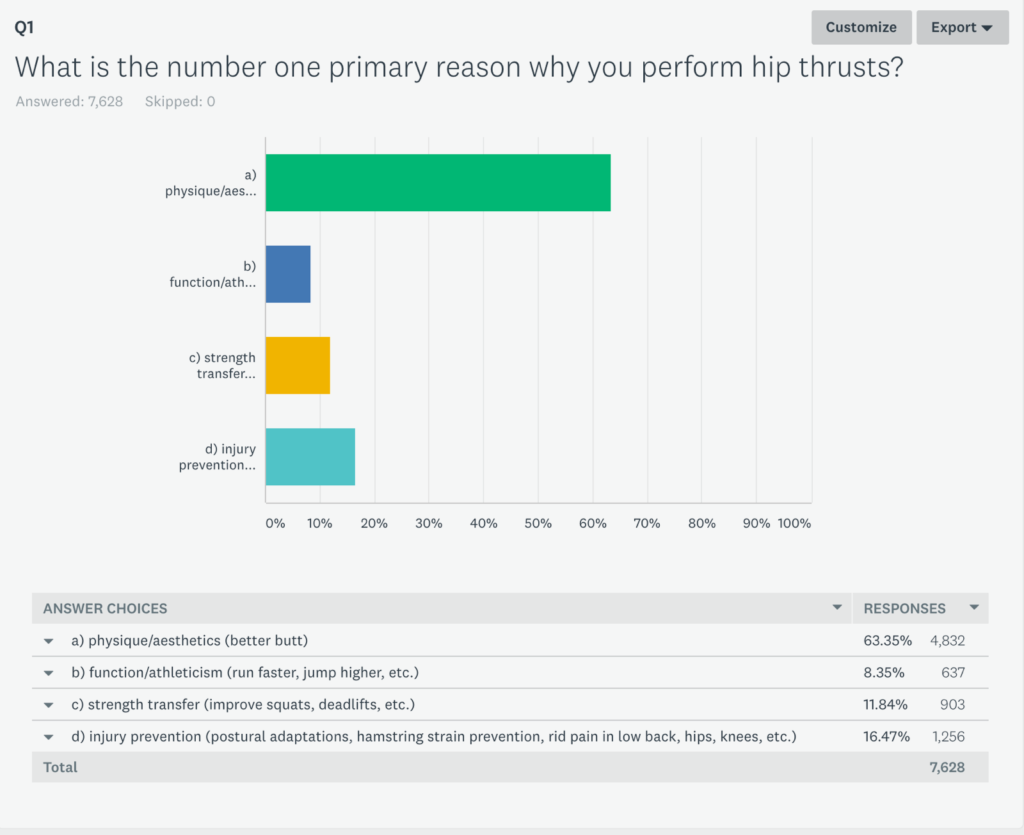

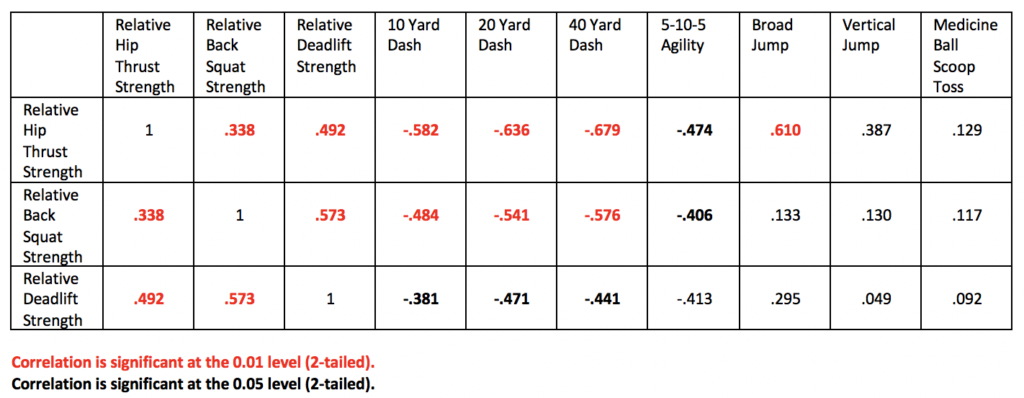
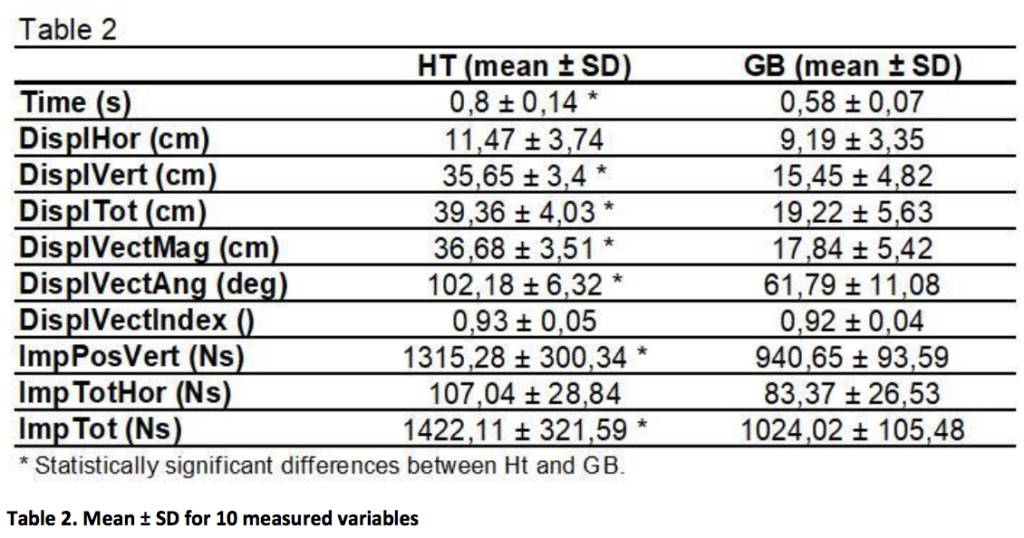





Just noticed you haven’t added “PhD” to your header on bretcontreras.com. I know you’re humble, but you worked hard for that bad boy. : )
Good call. I’ll get on this. Thanks Dunkman.
Hey Bret, not sure if you would be interested in adding this resistance combination?.
One wears a dog collar w/ d-ring, 2 ankle straps w/ d-rings & you clip the resistance band(s) length wise down the body from the neck to the ankles.
Have a video link of this JD? A dog collar LOL? This seems crazy.
I kind of fell like you shouldn’t click on that link.
Dude,
Did you invent the hip thrust because I always tell everyone you did?
Yes, barbell hip thrusts. I’m sure people did it before me, but to this day I’ve never seen any pics or videos of anyone doing them.
Hi Bret:
Congratulations for this article. Faboluos report for freaks of HT.
I have one question: Is there an electromyographic analysis for single-leg hip-thrust?
Thank you very much.
Not yet but I know someone is working on publishing this. I have data for it but just for a handful of subjects. Interested in seeing this as some people tend to love SLHTs and others not so much.
This is awesome and so worthy of a wiki page! Try yoyre a pioneer and I’m grateful for your knowledge and sharing of it! Thanks so much!! You rock or you thrust!! Haha!
My god. Just the length makes me want to read this. Right now, though, I’m going to derail here a tad. Any idea why my left erector (lumbar portion) hurts when I do 1 legged hip thrusts holds with my right leg doing about 20-30 degree abduction lifts (e.g I hold position, have right leg out and move it up and down). Doing it with the other leg – easy as anything, no pain. Could it be due to my right Transversus abdominis and other abdominal weakness? I think my rectus and obliques do not fire perfectly on my right side. Thank you very much.